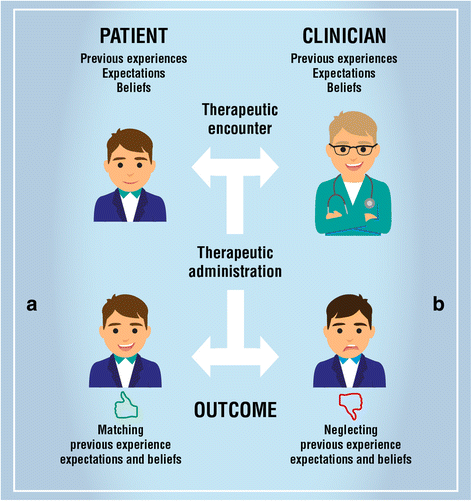Clinical relevance of contextual factors as triggers of placebo and nocebo effects in musculoskeletal pain
- PMID: 29357856
- PMCID: PMC5778801
- DOI: 10.1186/s12891-018-1943-8
Clinical relevance of contextual factors as triggers of placebo and nocebo effects in musculoskeletal pain
Abstract
Placebo and nocebo effects are embodied psycho-neurobiological responses capable of modulating pain and producing changes at different neurobiological, body at perceptual and cognitive levels. These modifications are triggered by different contextual factors (CFs) presented in the therapeutic encounter between patient and healthcare providers, such as healing rituals and signs. The CFs directly impact on the quality of the therapeutic outcome: a positive context, that is a context characterized by the presence of positive CFs, can reduce pain by producing placebo effects, while a negative context, characterized by the presence of negative CFs, can aggravate pain by creating nocebo effects. Despite the increasing interest about this topic; the detailed study of CFs as triggers of placebo and nocebo effects is still lacked in the management of musculoskeletal pain.Increasing evidence suggest a relevant role of CFs in musculoskeletal pain management. CFs are a complex sets of internal, external or relational elements encompassing: patient's expectation, history, baseline characteristics; clinician's behavior, belief, verbal suggestions and therapeutic touch; positive therapeutic encounter, patient-centered approach and social learning; overt therapy, posology of intervention, modality of treatment administration; marketing features of treatment and health care setting. Different explanatory models such as classical conditioning and expectancy can explain how CFs trigger placebo and nocebo effects. CFs act through specific neural networks and neurotransmitters that were described as mediators of placebo and nocebo effects.Available findings suggest a relevant clinical role and impact of CFs. They should be integrated in the clinical reasoning to increase the number of treatment solutions, boosts their efficacy and improve the quality of the decision-making. From a clinical perspective, the mindful manipulation of CFs represents a useful opportunity to enrich a well-established therapy in therapeutic setting within the ethical border. From a translational perspective, there is a strong need of research studies on CFs close to routine and real-world clinical practice in order to underline the uncertainty of therapy action and help clinicians to implement knowledge in daily practice.
Keywords: Clinical reasoning; Conditioning; Contextual factors; Expectation; Learning; Nocebo; Pain; Placebo; Therapeutic encounter; Therapeutic relationship.
Conflict of interest statement
Ethics approval and consent to participate
Not applicable.
Consent for publication
Not applicable.
Competing interests
The authors declare that they have no competing interests.
Publisher’s Note
Springer Nature remains neutral with regard to jurisdictional claims in published maps and institutional affiliations.
Figures




References
Publication types
MeSH terms
LinkOut - more resources
Full Text Sources
Other Literature Sources
Medical

